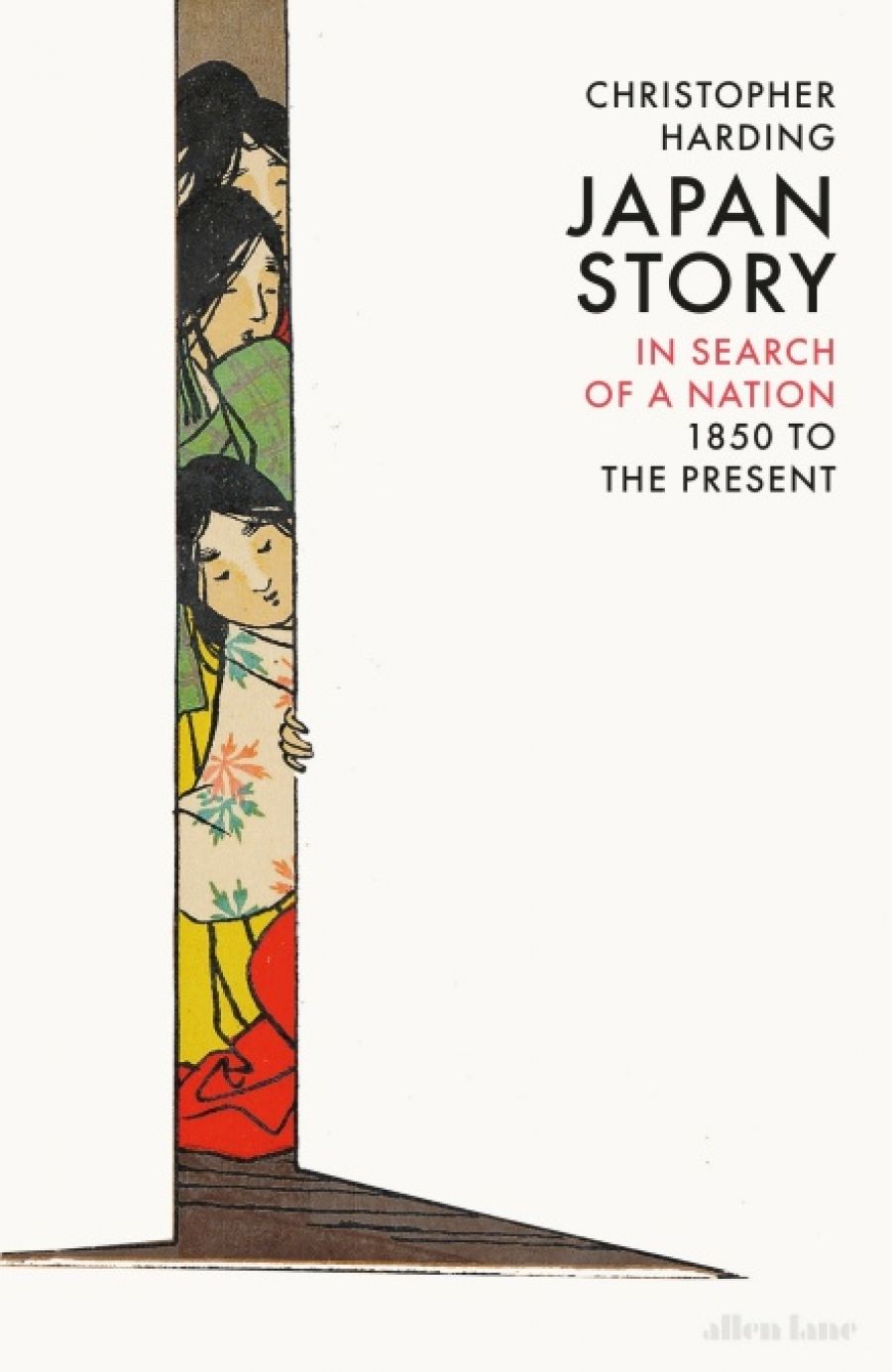
- Free Article: No
- Contents Category: History
- Custom Article Title: Alison Broinowski reviews <em>Japan Story: In Search of a Nation, 1850 to the present</em> by Christopher Harding
- Custom Highlight Text:
Our tutor in Japanese conversation at the Australian National University in 1968, rather than listen to us mangling his language, used to write the kanji for all the political factions on the board, with a Ramen-like chart of connections looping between them and multiple interest groups ...
- Book 1 Title: Japan Story: In Search of a Nation, 1850 to the present
- Book 1 Biblio: Allen Lane, $59.99 hb, 515 pp, 9780241296486
Christopher Harding shows that the story of Japan’s peaceful Westernisation and democratisation misses a lot: it should include the nation’s protracted wrestling match with itself, and the influence of individuals on the contest. Rebels, ultranationalists, and political thugs, inheriting a belief in righteous conflict, variously responded with ‘Japanese spirit’, wakon. Many of their names are not in our standard histories, and several were women.
 Portrait of Fukuda Hideko (福田英子, 1865 – 1927/Wikimedia Commons)One who certainly had wakon was an early feminist Kageyama Hideko, jailed for her part in the 1885 ‘Osaka Incident’ involving incitement of armed rebellion in Korea. In 1913, after her release, Kageyama proposed a ‘Solution to the Woman Problem’: communist revolution. Another feminist, Kishida Toshiko, campaigned against the precept, ‘Respect men, despise women’, which persisted into the Meiji era. The author Yosano Akiko wrote a famous poem imploring her brother to defy the emperor and not join the Russo-Japanese War of 1904–5. Evincing wakon of a different kind, Kanno Sugako conspired to throw a bomb at the emperor, and she was hanged for it.
Portrait of Fukuda Hideko (福田英子, 1865 – 1927/Wikimedia Commons)One who certainly had wakon was an early feminist Kageyama Hideko, jailed for her part in the 1885 ‘Osaka Incident’ involving incitement of armed rebellion in Korea. In 1913, after her release, Kageyama proposed a ‘Solution to the Woman Problem’: communist revolution. Another feminist, Kishida Toshiko, campaigned against the precept, ‘Respect men, despise women’, which persisted into the Meiji era. The author Yosano Akiko wrote a famous poem imploring her brother to defy the emperor and not join the Russo-Japanese War of 1904–5. Evincing wakon of a different kind, Kanno Sugako conspired to throw a bomb at the emperor, and she was hanged for it.
The Special Higher Police were empowered after Kanno’s 1910 assassination attempt to tackle ‘thought crimes’ against the state, such as a boy’s letter addressed to ‘Dear Stupid Emperor’, and references to His Majesty Hirohito as a ‘stupid bastard.’ National emergencies had repeatedly been invoked since the 1850s, but as economic conditions worsened in the 1920s and 1930s, Japanese saw themselves as misunderstood and threatened from east and west. Some blamed the rush to adopt European enlightenment ideas. Others took the guilt upon themselves for the national confusion.
General Araki Sadao banned the words ‘retreat’, ‘defence’, and ‘surrender’ in army literature, and claimed Japanese spirit, wakon again, was central to the army’s past and future success. Junior army officers from his Imperial Way Faction encircled the Diet and Army Headquarters with a thousand troops in 1936. Opposing this, a Control Faction argued for negotiating first, if only to give the weapons industry time to prepare for war, and Japan diplomatically achieved its occupation of French Indochina. But war began anyway against China in 1937, and ended in 1945, ‘not necessarily to Japan’s advantage’, as Hirohito, the ‘stupid bastard’ put it.
Necessity mothered invention, as Harding shows, with heartening examples of postwar wakon. Jazz pianist Akiyoshi Toshiko paired up with American star Hampton Hawes to make a living, giving concerts for the Occupation troops. Physicist Morita Akio made crude magnetic tape and a clunky tape recorder, and his colleague Ibuka Masaru, after a struggle to get finance, bought the US patent for prototype transistors, which they combined by 1955 into the Sony Walkman. Harding could also have mentioned Ishibashi (‘stone bridge’) Shōjirō, who, after inventing rubber-soled workmen’s footwear, moved on to make car tyres, and in 1931 established Bridgestone. Such success didn’t come easily: in the 1960s a senior executive at Japan National Railways said that reviving a 1930s high-speed train project was ‘the height of madness’ and ‘destined to fail’. Then came the Shinkansen, which now reaches most parts of Japan.
Young Japanese were sharply divided from their elders in the 1960s and 1970s about US military bases and the United States–Japan security treaty. Mass protest demonstrations were met by club-wielding opponents, some supported by rightist leaders and even, according to rumour, the CIA. Ishihara Shintarō’s novel and two films about the ‘sun tribe’ of rich young Japanese behaving badly caused public panic in the mid-1950s. But youthful rebellion morphed into mature conservatism, and Ishihara, a denier of the Nanjing Massacre, went on to represent the establishment as governor of Tokyo.
Environmental issues also caused contestation and mistrust. Hundreds of thousands were irradiated at Hiroshima and Nagasaki, and so were a Japanese fishing crew in 1954 by fallout from American nuclear tests at Bikini Atoll: yet Japan relied on nuclear power and American nuclear weapons. The effluent from a fertiliser plant was found to cause ‘Minamata disease’, yet the evidence was suppressed for years by the company and the government. Similar cover-ups preceded and followed the Fukushima ‘triple disaster’ of 2011.
The slogan for Osaka’s International Expo in 1970 was ‘Progress and Harmony for Mankind’, but disgruntled citizens displayed a one-word banner, ‘Bitterness’. Claims of social harmony and racial homogeneity are disputed; arguments go on about Japan’s ‘no-war’ Constitution and whether immigration is desirable to offset an ageing population; people question the worth of work. Harding’s wide-ranging psychoanalysis of the complex contest between mainstream and anti-mainstream is right about Japan, and brilliant.


Comments powered by CComment